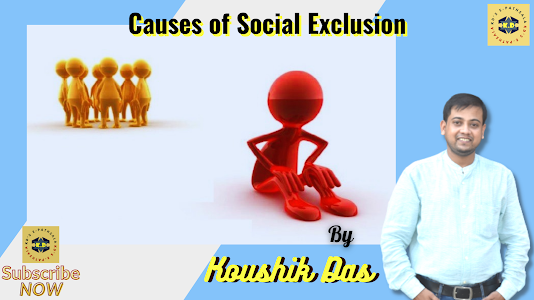Chronic poverty and youth unemployment is one of the main “Causes of social exclusion”. Social exclusion mainly refers to the inability of a society to keep all groups and individuals within the reach of what we expect as society to realize their full potential. Marginalization of certain groups or classes tends to occur in most societies including developed countries and perhaps it is more pronounced in transient economies like India. In India, the scheduled castes (SCs), the scheduled tribes (STs) and other backward castes (OBCs) are excluded social groups (Thorat Biradar 2007 and Biradar and Jayasheela 2007; Thorat 2004).
Exclusion of certain groups or classes of society from mainstream development is one of the more serious challenges facing the world in the 21st century. Social exclusion is one of the negative effects of economic restructure and transformation in most transient economies. Social exclusion is a phenomenon wherein individuals, social groups, or geographical areas tend to experience political, economic and/or social disadvantages, lack of confidence, a sense of powerlessness or a degree of social alienation, resulting from a combination of interrelated problems, such as regional disparities, unemployment, poor professional or social skills, low incomes, poor housing, high crime and violence. Social exclusion is used to describe a situation in which an individual, group or class is unable to participate in the basic political, economic and social functions of society (Silver 1994; de Haan 1998; Byrne 1999). Social exclusion is not merely a problem of economic disadvantages such as income poverty or unemployment.
Forms of Social Exclusion
Exclusionary processes can have various dimensions:
- Political exclusion can include the denial of citizenship rights such as political participation and the right to organise, and also of personal security, the rule of law, freedom of expression and equality of opportunity. Bhalla and Lapeyre (1997: 420) argue that political exclusion also involves the notion that the state, which grants basic rights and civil liberties, is not a neutral agency but a vehicle of a society’s dominant classes, and may thus discriminate between social groups.
- Economic exclusion includes lack of access to labour markets, credit and other forms of ‘capital assets’.
- Social exclusion may take the form of discrimination along a number of dimensions including gender, ethnicity and age, which reduce the opportunity for such groups to gain access to social services and limits their participation in the labour market.
- Cultural exclusion refers to the extent to which diverse values, norms and ways of living are accepted and respected.
Causes of Social Exclusion
- Low income : Low income is without doubt a key driver of social exclusion today. It is associated with a range of poor outcomes; many of these are long term. Income poverty is mainly driven by/associated with family type and employment circumstances. Over the recent past there has been a decline in pensioner poverty and an increase in child poverty and poverty in childless households. Those most at risk of social exclusion are the persistently poor – women and children, those living in lone parent households and single pensioner households. The Government is committed to the abolition of child poverty and tackling pensioner poverty. Despite the minimum wage, low wages, the non take-up of some means tested benefits such as Minimum Income Guarantee (now Pension Credit) and housing costs undermine the effectiveness of the improvements made to the safety net. But probably the most important fact is employment.
- Unemployment : Inability to participate in the labour market is generally considered a key indicator of social exclusion. Unemployment can be caused by other drivers of social exclusion such as ill-health, low educational attainment and lack of skills. Unemployment has been and still is falling, and employment both of men and women has been increasing. The proportion of lone parents in employment has been rising. The proportion of households without a person in employment is also falling, though it remains high. However, unemployment is spatially very concentrated and there are still areas with a considerable ‘jobs gap’. There has been an increase in pay differentials with more low pay and the risk of low pay affecting certain groups more – women, young people, older males, long-term sick and disabled, and ethnic minorities. The low paid are also more likely to experience unemployment. Unemployment has knock on effects in other dimensions of social exclusion including homelessness, health, crime, and drug and alcohol problems.
- Education : Education has a pivotal role in the intergenerational transmission of social exclusion. In general, attainment has been rising but a significant proportion still leave school without attaining qualifications and basic skills, and the attainment gap may be growing. There is clear evidence that attainment is a predictor of adult outcomes in work and earnings and probably has effects on health, depression, civic participation, interaction skills and motivation. A number of factors drive educational attainment, including child and family characteristics, school factors, the relationships between parents and school, and locality factors. On balance the evidence suggests that education can reduce social exclusion.
- Health : Health is associated with social exclusion in a variety of ways. Health status is a determinant of social position. Unhealthy behaviour can drive social exclusion, and social exclusion itself and the other drivers of it can result in poor health. Several subdomains under health were considered: problem drug use, alcohol misuse, mental health, teenage conceptions, child accidental deaths and premature death as illustrators of these relationships.
- Housing : Here, social exclusion was treated as covering those sleeping rough or staying in temporary and insecure forms of accommodation. Reasons for homelessness tend to be:
- structural factors such as housing shortages, unemployment and inequality, relationship breakdown and the closure of long stay hospitals;
- risk factors including family background, institutional history, socio-economic and health characteristics where there is a relationship in both directions – these all increase the risk of homelessness but also homelessness increases their risk; and
- Triggers, which are the events that precipitate homelessness such as leaving prison or local authority care. People living at the margins of the housing market are trapped by their social exclusion, economically weak, unable to access decent housing and many are not ready to live in accommodation of their own.
- Transport : Lack of affordable, reliable and safe transport can restrict access to work, education, services, and food shopping and socio-cultural activities. The growth of the car culture has in many ways exacerbated the problems of those without access to a car that have to rely mainly on buses, which can be expensive, inconvenient, unreliable and unsafe. Public expenditure on transport is regressive and dominated by the car.
- Social capital : Social capital is a concept about which there is still a degree of confusion. Most of the UK writing on the subject is theoretical. Empirical work suggests social capital is lower in areas of poverty, though there is some evidence that employment may inhibit the development of relationships and networks that enhance social capital at home.
- Crime : The most powerful drivers of crime are community deprivation and income inequalities resulting from unemployment. Crime is spatially concentrated and associated with homelessness, poor health, parenting factors, drugs and alcohol misuse, school exclusion, leaving care and prison. A criminal record is itself likely to lead to exclusion, having an impact on the chances of obtaining employment in particular.
- Fear of crime : Fear of crime varies by neighborhood and individual characteristics, with a strong association with age, gender and ethnicity. However, poor people are more likely to fear crime.
______________________________




